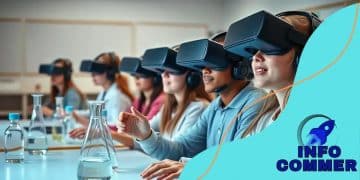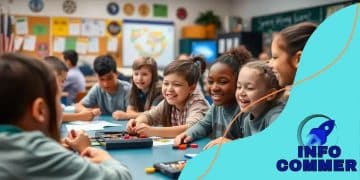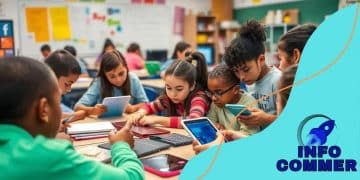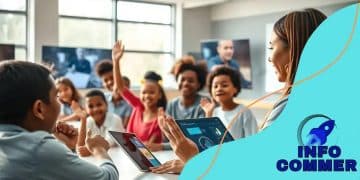How AR is being used for hands-on learning experiences
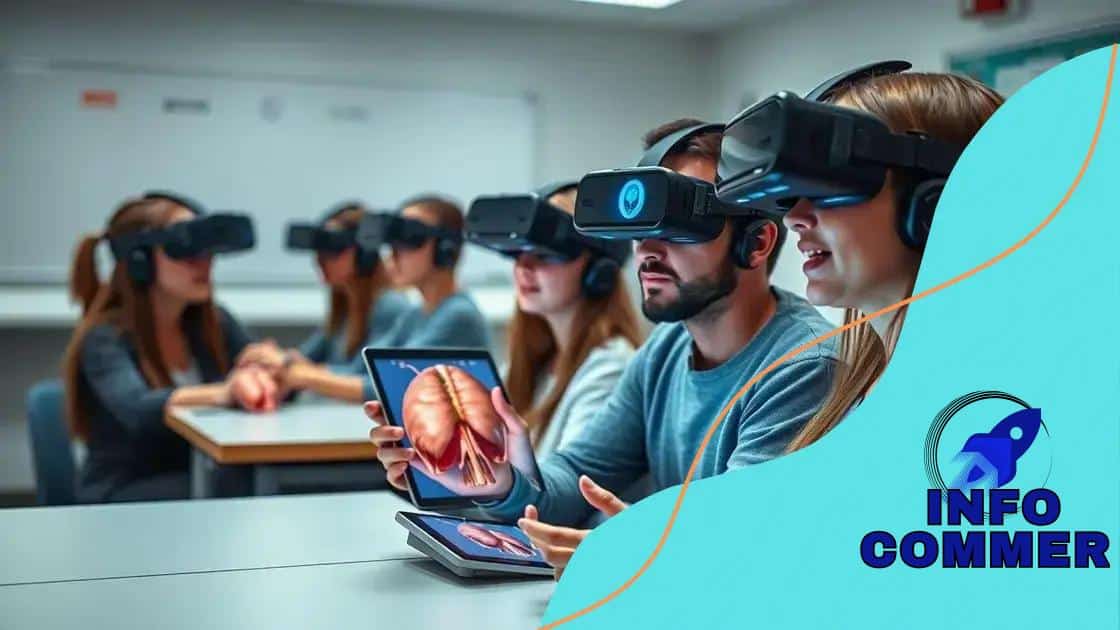
Augmented reality is transforming education by enhancing student engagement, improving understanding of complex topics, and fostering collaboration, while also presenting challenges like costs and the need for teacher training.
How AR is being used for hands-on learning experiences is changing the way students engage with their studies. Imagine learning anatomy by virtually dissecting a body or exploring ancient civilizations through immersive simulations—wouldn’t that make learning more exciting?
Understanding augmented reality in education
Understanding augmented reality in education is key to grasping how technology can enhance learning experiences. This exciting tool merges digital information with the real world, creating a rich environment for students.
What is Augmented Reality?
Augmented reality (AR) overlays digital content onto the physical world. This means students can see 3D models, videos, and animations through devices like tablets or smartphones. For instance, when studying geology, students can visualize rock formations right in front of them, which reinforces their understanding.
Benefits of Augmented Reality in Education
Using AR in schools brings many advantages:
- Enhanced engagement: Students are more interested and excited about learning when they can interact with content.
- Improved understanding: Complex topics become easier to grasp through visual representation, enhancing comprehension.
- Personalized learning: AR accommodates diverse learning styles, allowing students to learn at their own pace.
By integrating augmented reality into lessons, educators can create immersive experiences. Imagine students exploring the human body through a virtual dissection. They can rotate, zoom in, and interact with biological structures, which is far more engaging than reading from a textbook. This interactive approach not only aids retention but also sparks curiosity.
In addition, AR encourages collaboration among students. They can work together to solve problems using shared digital content, fostering teamwork and communication skills. As they interact with both their peers and the technology, students develop a deeper understanding of the subject matter.
Real-World Examples
There are already numerous successful implementations of AR in the classroom:
- Science simulations: AR apps allow students to conduct virtual experiments without the need for physical lab equipment.
- History lessons: They can experience historical events or visit ancient ruins through augmented experiences.
- Language learning: Students can practice vocabulary and grammar in a dynamic, engaging way.
Overall, understanding augmented reality in education reveals how it transforms traditional learning into interactive and fun experiences. By embracing this technology, teachers can capture students’ imaginations and enhance their educational journeys.
Benefits of AR for hands-on learning
The benefits of augmented reality (AR) for hands-on learning are transforming education. By making lessons interactive and immersive, AR increases student engagement and understanding.
Enhanced Engagement
AR grabs students’ attention like traditional methods cannot. When learners see digital elements layered onto the real world, they become active participants in their education. Imagine a student observing a 3D model of a cell on their desk; this visual stimulation makes learning memorable.
Improved Comprehension
With augmented reality, difficult concepts become clearer. By visualizing content, students grasp complex subjects more easily. For instance, in science classes, students can explore the anatomy of a frog through a virtual dissection. This hands-on experience reinforces their learning and boosts information retention.
- Interactive learning: Students can manipulate 3D models, enhancing their understanding of spatial relationships and structures.
- Real-world connections: Lessons become relevant to students’ lives, making education more impactful.
- Visual stimulation: Engaging visuals cater to different learning styles, ensuring that all students benefit.
Another important aspect is that AR accommodates varying learning paces. Each student can interact with the material at their own level. A student struggling with phylogenetics can revisit digital models repeatedly until they feel confident. This personalized learning approach fosters independence and self-directed study.
Collaborative Opportunities
AR also promotes collaboration among students. They can work together on projects, sharing insights while using AR applications. This teamwork cultivates essential communication skills that will aid them in their future careers. By discussing and collaborating on AR-based tasks, students develop a sense of community.
The expanding use of augmented reality in education highlights its importance. As technology evolves, so too does the potential for AR to enhance learning experiences. Schools that integrate AR into their curriculum are preparing students for a more tech-centric future while making learning enjoyable.
Examples of AR applications in classrooms

Examples of AR applications in classrooms demonstrate how technology can enhance the learning experience. Teachers are increasingly using augmented reality to engage students and make learning more interactive.
Virtual Field Trips
One popular application is the use of virtual field trips. Students can explore places they may never visit in real life. For instance, they can take a virtual tour of the Louvre to see famous artworks, all from their classroom. This type of learning helps students connect with the material, making education more engaging.
Interactive Science Lessons
In science classes, AR allows students to observe complex processes. For example, a lesson on the solar system can transform into an interactive experience. Students can see planets rotating and understand their movements in a 3D space. This visual engagement helps solidify their knowledge.
- Biology lessons: Students can study the anatomy of animals by viewing 3D models. They can even dissect a virtual frog to learn about its organs.
- Chemistry experiments: Students can conduct virtual experiments, mixing elements to see reactions without any danger of spills or accidents.
- Geography studies: AR can overlay topographical information on maps, helping students visualize landscapes and geographical features.
Another exciting application of augmented reality is in language learning. Students using AR headsets can immerse themselves in different environments where they practice the language they are learning. For example, they can be virtually placed in a French café, helping them learn vocabulary and pronunciation in context.
In history classes, AR can recreate historical events. Students can witness significant moments like a battle or the signing of a peace treaty. Experiencing history firsthand makes it more memorable and impactful.
Art and Creativity
In art classes, students can use AR tools to design and visualize their creative projects. They can paint or draw with virtual enhancements, bringing their ideas to life with vibrant colors and interactive elements. This integration of technology encourages creativity and experimentation.
With these AR applications, students gain hands-on learning experiences that traditional lessons cannot provide. This technology makes education interactive and fun, transforming how we think about learning in the classroom.
Challenges of implementing AR in education
Challenges of implementing augmented reality (AR) in education can impact its effectiveness in classrooms. While AR has many benefits, schools face obstacles as they integrate this technology into their curriculum.
Cost of Technology
One major challenge is the cost involved in adopting AR tools. Schools often operate under tight budgets, and purchasing devices like tablets or AR headsets may not be feasible for all institutions. In addition to hardware costs, there are expenses related to software, training, and maintenance, which can discourage schools from moving forward with AR implementation.
Technical Skills and Training
Another significant hurdle is the need for proper training. Teachers must understand how to effectively use AR in their classrooms to maximize its benefits. Without adequate training, the technology may be underutilized or misapplied. Schools need to invest in professional development to ensure that educators feel confident in using AR and integrating it into their lesson plans.
- Access to resources: Not all students have equal access to the technology needed for AR. This digital divide can lead to disparities in learning opportunities.
- Technical issues: Like any technology, AR systems can experience glitches or malfunctions, making it difficult for teachers and students to rely on them during lessons.
- Curriculum alignment: Teachers may struggle to incorporate AR into existing lesson plans, causing disruptions in learning flow.
In addition, the pace of technological change presents challenges. AR tools evolve rapidly, requiring consistent updates and adjustments in educational strategies. Schools must stay informed about the latest innovations to keep their programs relevant and effective. This ongoing need for adaptation can be daunting for educators already managing multiple responsibilities.
Student Distractions
While AR can enhance learning, it can also be a source of distraction. Students may become overly focused on the novelty of the technology instead of the content being taught. Teachers must find a balance to ensure that AR enhances rather than detracts from the learning experience. Building guidelines around the appropriate use of AR is essential for maintaining engagement.
Ultimately, understanding the challenges of implementing augmented reality in education is crucial for schools. By addressing these issues, educators can create a more effective and enriching learning environment that harnesses the full potential of AR technology.
Future trends in AR learning experiences
Future trends in AR learning experiences promise to revolutionize education in exciting ways. As technology continues to advance, educators will find new methods to engage students through augmented reality.
Integration with AI and Machine Learning
One significant trend is the integration of AR with artificial intelligence (AI) and machine learning. This combination allows for personalized learning experiences tailored to each student’s needs. For example, AR applications can analyze a student’s learning pace and adjust difficulty levels automatically. This way, students can progress at their own speed, making learning more effective.
Enhanced Collaboration
Another emerging trend is the focus on collaborative learning environments. As AR technology evolves, students will be able to engage in shared virtual spaces, regardless of their physical location. This means students in different classrooms can work together on projects using AR. Imagine students from different countries discussing and creating a joint history project while experiencing the same historical event through augmented reality.
- Increased accessibility: Future AR experiences may provide better access for students with disabilities, making learning more inclusive.
- Integration with wearable tech: Devices such as AR glasses may allow for hands-free interaction with digital content, making it easier for students to engage with lessons.
- Real-time data analytics: Teachers may receive instant feedback on student engagement through AR applications, allowing for timely interventions.
As AR technology progresses, it will likely offer seamless integration with other digital tools. This means students can switch between AR and other learning platforms effortlessly. For example, they may start a lesson about a historical event in AR and then seamlessly transition to a traditional lesson on the same topic using digital textbooks.
Gamification of Learning
The gamification of education through AR will be another significant trend. By blending learning materials with game elements, students will find studying more enjoyable and engaging. Gamification can introduce challenges and rewards that motivate students to actively participate in their education.
For instance, a classroom might use AR to turn field trips into adventure games, where students can earn points by completing tasks or solving puzzles related to their lessons. This encourages exploration and deeper understanding of the material.
Overall, the future of AR learning experiences is bright. As these technologies continue to evolve, they will offer innovative ways to engage students, foster collaboration, and create personalized learning paths.
augmented reality is changing how we learn in schools. It offers exciting ways to engage students and deepen their understanding of complex topics. As technology advances, we can expect AR to become an essential tool in education, helping create personalized, immersive, and interactive experiences. However, challenges such as costs, training, and distractions must be addressed to fully harness its potential. With careful planning and implementation, AR can transform learning for the better.
FAQ – Frequently Asked Questions about Augmented Reality in Education
What are the main benefits of using augmented reality in classrooms?
Augmented reality enhances student engagement, improves comprehension of complex subjects, and allows for personalized learning experiences.
What challenges do schools face when implementing AR technology?
Key challenges include high costs, the need for teacher training, and ensuring equal access for all students.
How can augmented reality foster collaboration among students?
AR allows students to work together in virtual environments, even if they are in different locations, enhancing teamwork and communication skills.
What future trends can we expect in augmented reality for education?
Future trends include integration with AI for personalized learning, increased use of gamification, and improved collaborative tools.
